Once you’ve found your ancestor’s birth or baptism record, you can search for them in census records online by name and birth year (although bear in mind that you may need to be flexible on those details, as some individuals have a different age or spelling of their name in different records). A national census of the UK has been carried out every ten years since 1801 (apart from 1941, when it was cancelled due to the Second World War) and the records are made public after 100 years.
Ireland ceded from the United Kingdom in 1922. Between 1821 and 1911, Irish censuses were carried out at the same time as British ones. Only the 1901 and 1911 censuses for Ireland survive in full, although you can use census substitutes to take your research back further.
Every census since 1841 has included a complete list of all the residents of a household, including details such as their age, place of birth and occupation. It’s therefore a great way to find out where your ancestors lived and uncover their children and other family members.
The complete censuses from 1841 to 1921 survive and can be found on all the major family history websites, except the 1921 census which is only available on Findmypast and Ancestry and the 1911 and 1921 censuses for Scotland which are only available on ScotlandsPeople (early Scottish censuses are available as transcripts elsewhere, but to see the actual documents, you also need to visit ScotlandsPeople). Some pre-1841 census fragments survive. The Early British Census Project is a good resource for tracing them.
Below, we explain when each census was taken, what information was included in each census and how to access UK census records online, including websites that offer free access to UK census records.
Can't find someone in UK census records? Check out our expert tips on finding 'missing' people in the census
- The 1931 census
- The 1921 census
- The 1911 census
- The 1851-1901 censuses
- The 1841 census
- The 1831 census
- The 1821 census
- The 1811 census
- The 1801 census
When was the 1931 census taken?
The 1931 census was taken on 26 April 1931.
When will the 1931 census be released?
Unfortunately, the 1931 census records for England and Wales were destroyed in a fire on 19 December 1942. The 1931 census records for Scotland survive and are due to be released on ScotlandsPeople in 2031. The next national census release encompassing England, Wales and Scotland will be the release of the 1951 census records in 2052.
When was the 1921 census taken?
The 1921 census was taken on 19 June 1921. The census date was delayed by two months because of a threatened general strike.

What information was included in the 1921 census?
The 1921 census was the most detailed one yet. It asked respondents to give their age in years and months instead of just years. For the first time, adults were given the option to say if they were divorced as well as single, married or widowed. Children's entries asked whether they had both parents living, a dead father, a dead mother, or both parents dead. Respondents were also asked to give the name of their employer and their place of work.
Where can the 1921 census be found online?
The 1921 census for England and Wales is available on Findmypast via the website's Premium subscription tier and on Ancestry via the website's 'All UK and Ireland' and 'All Records' subscription packages. The 1921 census for Scotland is available on ScotlandsPeople at a cost of six credits (worth £1.50) to view each record.
When was the 1911 census taken?
The 1911 census was taken 2 April 1911. For the first time in 1911 for England and Wales we see the original forms completed in the householder’s own handwriting, rather than a transcribed copy from the enumerator’s book. John Underwood, a 47-year-old butcher from Hastings, admitted in the health conditions column that he was ‘bad-tempered’, his wife was ‘long-tongued’ and their five children were ‘quarrelsome’, ‘stubborn’, ‘greedy’, ‘vain’ and ‘noisy’! Notes like this may have been jokingly scribbled on earlier censuses but unfortunately the original forms no longer survive. In Scotland the household schedules were destroyed and the entries were transcribed into enumerators books, just as with previous censuses.
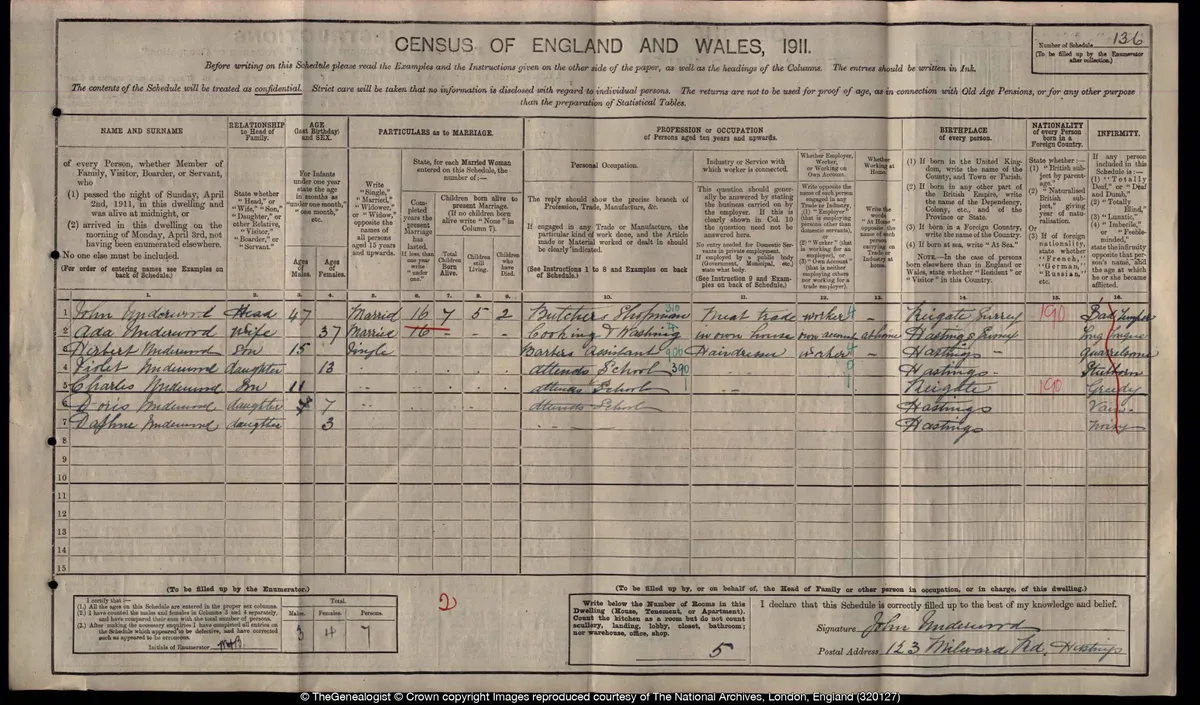
What information was included in the 1911 census?
The information on the 1911 census records includes questions relating to children born within a marriage. The married women were to state how many years the present marriage had lasted and how many children had been born alive to that marriage along with how many had died and how many were still alive.
As these questions were new, they confused some households who sometimes included children they had with previous marriages or children who had been born out of wedlock. Some people even enumerated their dead children, providing names and other details invaluable to family historians!
Where can the 1911 census be found online?
Ancestry
Index and images for England and Wales. Also 1911 Irish census records can be searched from here.
The National Archives of Ireland - FREE
The 1911 Irish census records are freely available.
FamilySearch - FREE
Basic index shared with Findmypast for England and Wales (the index is free but images are not included). Also 1911 Irish census records can be searched from here and links through to the National Archives of Ireland website above.
Findmypast
Index and images for England and Wales. Also 1911 Irish census records can be searched from here.
ScotlandsPeople
The only place online where you can access an index and images of the 1911 Scottish census records. The Scottish images do not show household schedules as they do for England and Wales, just the entries copied into enumerators' books.
TheGenealogist
Index and images of census records for both England, Wales and Ireland. Occupation indexed.
MyHeritage
MyHeritage has images and transcriptions for the English and Welsh censuses.
When were the 1901, 1891, 1881, 1871, 1861 and 1851 census taken?
The 1901 census was taken 31 March 1901.
The 1891 census was taken 5 April 1891.
The 1881 census was taken 3 April 1881.
The 1871 census was taken 2 April 1871.
The 1861 census was taken 7 April 1861.
The 1851 census was taken 30 March 1851.
What information can be found in UK census records 1851-1901?
The census records gradually became more detailed with every decade that passed. Marital statuses were given from 1851, as well as the relationship between each person and the head of the household. Ages also became more accurate as well as information about where someone was born.
Increasingly intrusive enquiries were made, asking in 1851 and 1861 if people were ‘blind or deaf-and-dumb’ and from 1871 whether anyone was deemed to be a ‘lunatic, imbecile or idiot’, by Victorian standards. Additional questions were asked about employment status from 1891, defining whether a person was self-employed ‘on their own account’, an employer, or employed by someone else.
Address - Street and house name or number were included in the census records. Enumerators also tried to include Gypsies and the homeless so 'address' might be 'Under canal bridge' or 'Tents on common'. From 1861 uninhabited houses were also recorded.
Name - Full names for all occupants were given (although usually just initials for middle names). In some institutions, especially prisons, just initials for both first and last names were given.
Relation to head of household - Wife, son, dau (daughter) are the most common family ones but you may find extended family there as well as servants and lodgers. Institutions would have inmates, pupils, patients, staff etc
Condition - This recorded an inhabitants' marital status: M or Mar for married, W or Wid for widow/er and S or sometimes U for unmarried.
Age - Unlike previous census records, ages were recorded accurately (or as accurately as the inhabitant knew or cared to give). There were two columns, one to record the ages of male inhabitants and one for female.
Rank, profession or occupation - Wives are often left blank even though they may have worked. Administrators recognised that the work of women was not being recorded and added a box in 1901 'If working at home' to try and encourage a better record of female employment. Children attending school were marked as 'Scholar'. From 1891 further columns were added asking if someone was an employer, an employee or neither.
Where born - More complete details were now required, including town or village and county. Those born abroad, including Ireland, only had to provide the name of the country.
Disabilities - In 1851 and 1861 the census asked if you were 'Blind or Deaf and Dumb'. From 1871 two more categories were introduced: 'Imbecile or idiot' (changed to 'Feeble-minded' in 1901) or 'Lunatic'.
Education - From 1861 onwards, Scotland administered its own census and could add its own questions. In 1861 and 1871 Scotland asked how many children between 5 and 15 were being educated at school or at home.
Housing condition - The 1861 to 1901 censuses in Scotland asked how many rooms had one or more windows. This was a reaction to concern about housing conditions. In 1891 and 1901 English and Welsh households had to say how many rooms they inhabited if it was less than five to assess the issue of overcrowding.
Language spoken - In 1881 the Scottish census asked whether the inhabitants spoke Gaelic or G&E (this was left blank if they did not speak Gaelic). In 1891 a similar question was added to the Welsh census asking inhabitants if they spoke Welsh. It was not until 1901 that Welsh language schedules were provided for Welsh speakers.
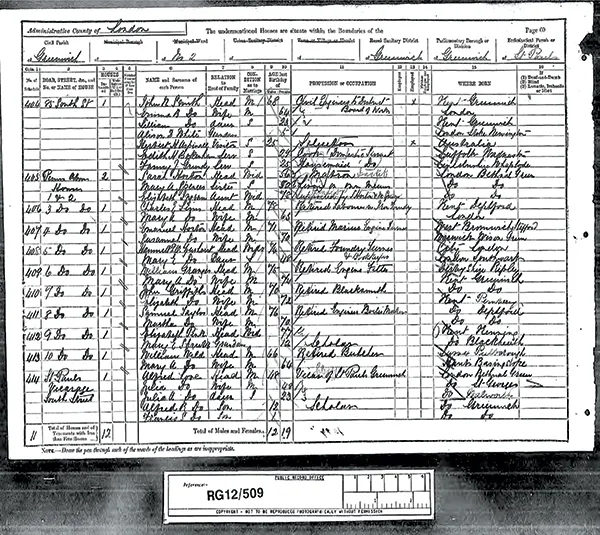
Where can the 1851-1901 UK census records be found online? And which websites have the best census images for which years?
Ancestry (1881 census FREE)
Index and images for England and Wales, index-only for Scotland. Occupation indexed only for Scotland except for 1881 census. Census images best for 1901, 1861 and 1851.
The National Archives of Ireland - FREE
Only a small number of records for some areas in Ireland survive pre-1901. The site also has census search forms filled in by people claiming an Irish pension checked against the 1841 and 1851 census. The 1901 and 1911 census though is completely and freely available.
FamilySearch - FREE
Basic index shared with Findmypast for England and Wales (the index is free but images are not included). Occupations not indexed. Also some Irish records for 1851 and an index to the Irish 1901 and 1911 census that links through to the National Archives of Ireland website above.
Findmypast
Index and images of census records for England and Wales, index-only for Scotland. Occupation indexed only for Scotland except for 1851 and 1881 census for England and Wales. Census images best for 1891, 1871 and 1861.
FreeCEN - FREE
Great free index for England, Wales and Scotland. Good search options including occupation. No images. Not every county is complete yet, especially for later decades.
ScotlandsPeople
Images and an index of Scottish census records from 1841 to 1911 on this pay-as-you-go website.
TheGenealogist
Index and images for both England and Wales and indexes for Scotland and the 1891 and 1901 Irish censuses. The only website to have occupation indexed for all censuses and to have indexed street addresses linked to maps. The census images have been rescanned for better image quality.
MyHeritage
MyHeritage has images and transcriptions of the English and Welsh records and transcriptions only for Scotland. Good census images for all decades.
When was the 1841 census taken?
The 1841 census was taken on 6 June 1841. It was the first modern census that attempted to list the names of every person in the British Isles. It was also the first to compile the enumerators’ notes in pre-printed books and keep those books.
What information was included in the 1841 census?
Street and house number – Where more than one household shared a house, the enumerator separated the household with a single slash (/). A double slash (//) was used to indicate a new house.
Names – Everyone in the house on census night was supposed to be included although their relationship to the head of the household was not. A woman who shares the same surname as the head of the household and is a similar age may well be his wife but could also be a spinster sister, for example.
Age and sex – Only those under 15 were supposed to have their exact age entered. Those over 15 were meant to have their age rounded down to the next multiple of five, so someone who was 44 would be marked as 40. Many enumerators were confused by this and so it is not unusual to find exact ages included in the census records, although bear in mind that your ancestor may not have given their correct age.
Employment – Common occupations were shortened. For example ‘FS’ or ‘MS’ for male or female servant, ‘Ag Lab’ for agricultural labourer, ‘P’ for pensioner (army), ‘Ap’ for apprentice, ‘J’ for journeyman, ‘M’ for maker, ‘Sh’ for shop keeper and ‘Ind’ for independent means.
Where born – For the first time the census records asked a question about where people were born. Inhabitants were asked whether they were born in the county they were currently living in and whether they had been born abroad (including Scotland and Ireland).
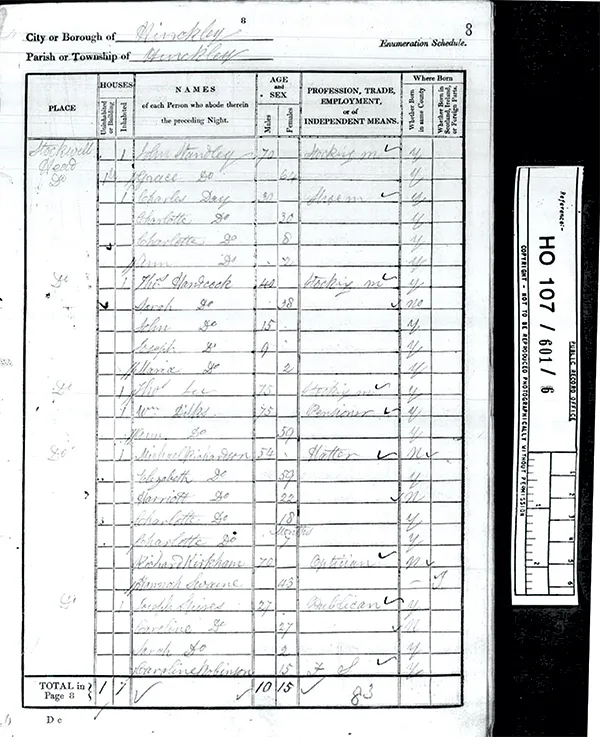
Is the 1841 census online?
The UK 1841 census records are widely available online both on subscription and free websites. Because 1841 census records were recorded in pencil, they can sometimes be very faint and difficult to read. Ancestry rephotographed some pages making them easier to read but on other pages TheGenealogist has digitally enhanced the images making them easier to read. Similarly some pages are easier to read on Findmypast. If you cannot read an entry, try looking at the same example on a different website.
Ancestry
Index and images for England and Wales, index-only for Scotland. Occupation indexed only for Scotland. Irish index links to National Archives of Ireland (NAI).
The National Archives of Ireland - FREE
Only records for some areas in Ireland survive. The site also has census search forms filled in by people claiming an Irish pension checked against the 1841 and 1851 census.
FamilySearch - FREE
Basic index shared with Findmypast for England and Wales (the index is free but images are not included). Index and images for the small number of surviving Irish records from NAI (see above). Occupations not indexed.
Findmypast
Index and images for England and Wales, index-only for Scotland. Occupation indexed only for Scotland. Irish index to some NAI records. The British and Irish census records are available in all Findmypast subscription tiers.
FreeCEN - FREE
Great free index for England, Wales and Scotland. Good search options including occupation. No images. Not every county is complete yet.
ScotlandsPeople
Images and an index of Scottish census records.
TheGenealogist
Index and clear images of census records for both England and Wales and indexes for Scotland. Includes searchable occupation and address. Best images for 1841 census.
When was the 1831 census taken?
The 1831 census was taken on 30 May 1831. There was a lot of political and social turmoil at the time so little change was made in how the information was collected.
What information was included in the 1831 census?
The 1831 census records are similar to previous ones. However, more detailed questions were asked about occupation.
Street – Both name of street and house number were included as a matter of course now.
Name of householder – As before with some exceptions such as in Penketh Lancashire, only the head of household was named, although a tally of males and females was kept as well as the number of families in the household.
Occupation – There were now seven categories instead of three including one for the middle classes ‘Wholesale Merchants, Capitalists, Bankers, Professional Persons and Other Educated Men’. At the other end of the scale was ‘Superannuated Labourers, and Males Diseased and Disabled in Body or Mind.’
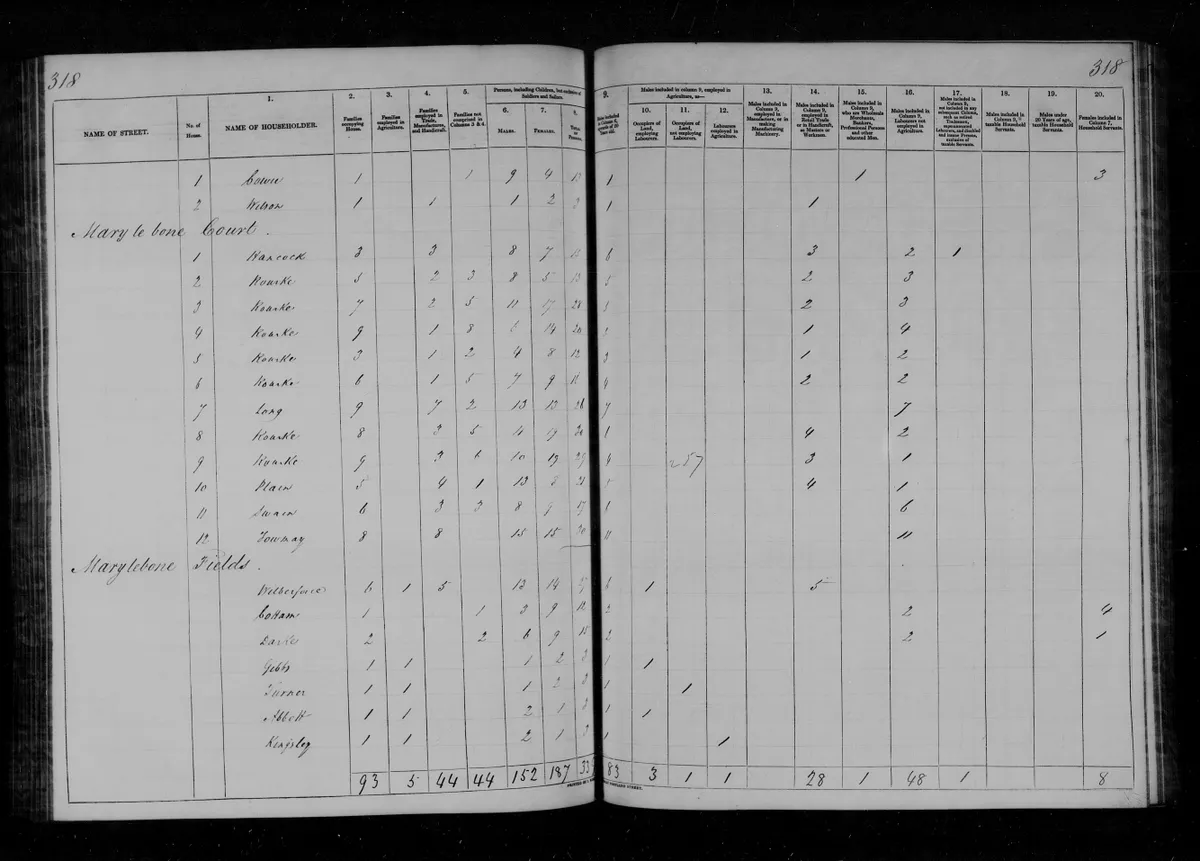
Is the 1831 census online?
As with other early UK census records surviving examples are held locally and not many have gone online.
National list of surviving records
Early British Census Project - various parishes and growing
Ireland
Scotland - Scottish Indexes has some 1831 census records from Berwickshire and Roxburghshire indexed. You can pay to obtain a copy of the original record.
Derbyshire
Harrow - an extremely rare collection of 1831 census records actually filled in by the households found in the Harrow Poor Law records on Ancestry.
London, Westminster Marylebone
Nether Hallam, Sheffield
Shrewsbury
When was the 1821 census taken?
The 1821 census was taken on 28 May 1821. This was the first time that Ireland was included in the census. Unlike in Scotland, where the enumerators were schoolmasters, and England and Wales, where the enumerators were employed by the Poor Law unions, in Ireland, where hostility to the census was expected, enumerators were recruited from the police.
What information was included in the 1821 census?
The Irish 1821 census records hold more details than were requested elsewhere in the British Isles.
Street – Houses were more likely to be numbered at this stage making it easier to locate exactly where people lived.
Names of Inhabitants – In Ireland the census records asked for the names of all inhabitants. For the rest of the UK, as before, just the head of the household was supposed to be enumerated with notable exceptions e.g. the Dunsford, Cheriton Bishop and Tedburn St Mary examples from Devon on Findmypast which also included relationship to the head of household.
Age – In Ireland, the exact age of all inhabitants was included. Elsewhere most returns just put numbers of females and males in ten-year age categories.
Occupation – In England, Wales and Scotland the categories stayed the same as previous censuses, although some enumerators included precise occupations. In Ireland, exact occupations were included as was status for women e.g. widow, spinster or married.
Observations – In the Irish 1821 census records there is a column for observations that can be useful, for example adding details about visitors. Always check the original image.
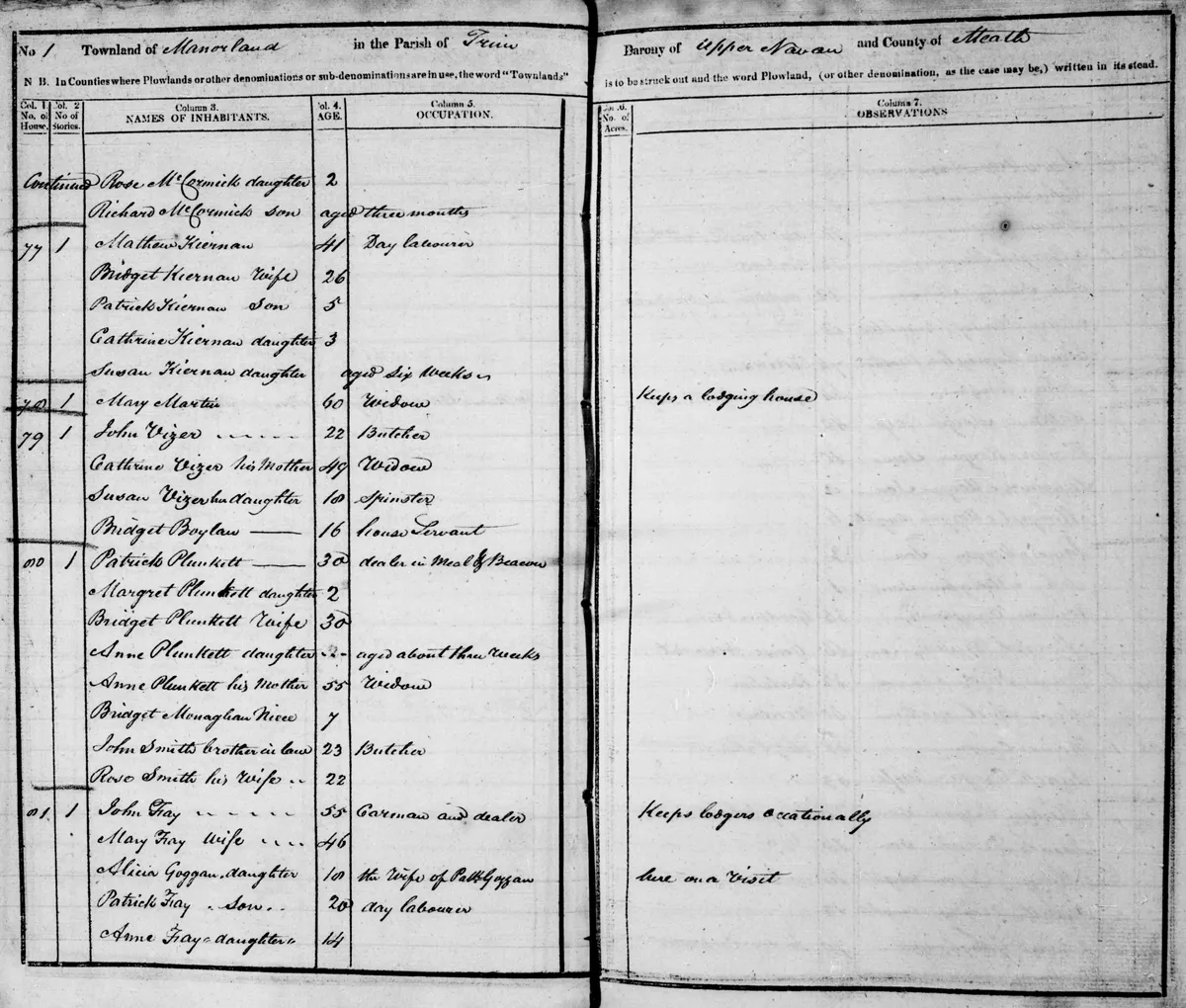
Is the 1821 census online?
What survives of the 1821 Irish census records are online. There are also some examples from elsewhere in the British Isles including detailed census records from the Orkney Islands which are freely available on Findmypast.
National list of surviving records
Early British Census Project - various parishes and growing
Ireland - the surviving records for the Irish 1821 census are free to access online
Dartford, Kent available on Findmypast
Dunsford, Cheriton Bishop and Tedburn St Mary, Devon available on Findmypast
Marylebone, London available as an index only on Findmypast.
Orkney, Scotland freely available on Findmypast
When was the 1811 census taken?
The 1811 census was taken on 27 May 1811. Britain was still in the Napoleonic Wars and was about to embark on a war with the USA. The notebooks compiled by the enumerators were not required by the census authority. Many were discarded, but some survived in parish chests or account books of the overseers of the poor.
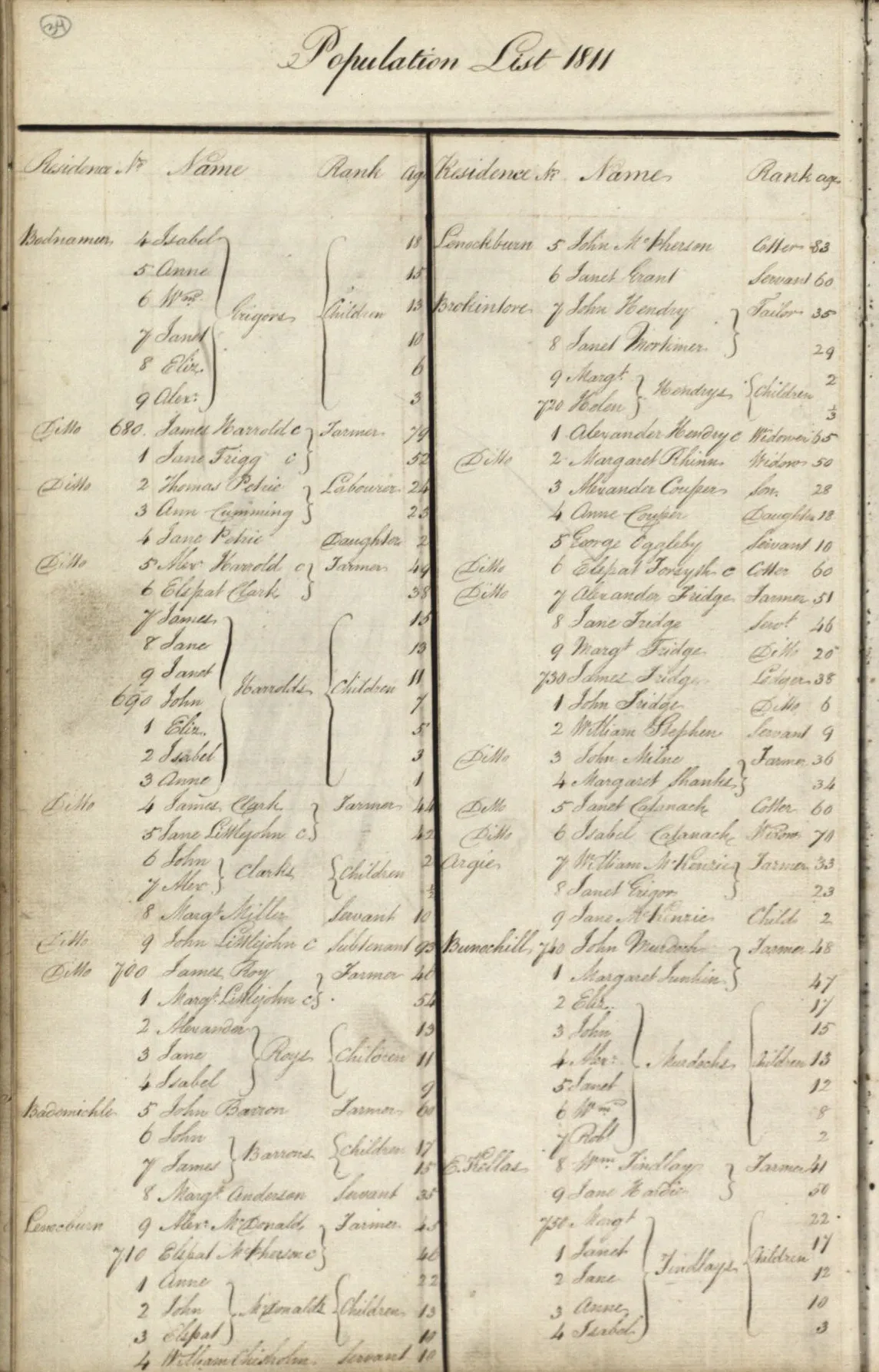
What information was included in the 1811 census?
Information in the 1811 census records is similar to that in 1801, although rather than asking what the occupation for the head of the household was, residents were asked what the occupation of the family was. Again, information in the census records varies across the UK, but commonly includes:
Street – Including more house numbers this time.
Head of household – As before, only the head of household's name was required.
Number of males and females in the household
Occupation of family: agriculture; trade, manufacturing or handicraft; or other.
Is the 1811 census online?
There are very few census records from the 1811 census online, but check the catalogues of local and national record offices to find surviving examples. Where records survive, check local family history societies for indexes on Parish Chest.
National list of surviving records
Early British Census Project - various parishes and growing
Scotland - Scotlands People has some 1811 records from Berwickshire indexed. You can pay to obtain a copy of the original record.
Ashcott, Somerset (can only be viewed at a FamilySearch affiliate library or family history centre)
Ealing, London
Honley, Yorkshire
When was the 1801 census taken?
The 1801 census was taken on 10 March 1801 during the Napoleonic Wars and was intended to gather statistical information to manage increasing demand for food and gauge how many men were of military age.
What information was included in the 1801 census?
There was no set pre-printed form for enumerators, so information was recorded differently depending on the area. On the whole the 1801 census records show:
Street – Sometimes names of houses were included but houses rarely had numbers at this time.
Head of household – Only the head of each household is usually recorded although sometimes, for example in Illington, Norfolk, the enumerator recorded the names of everyone.
Living quarters – People were asked whether the family lived in the cellar, back house or front house. Those living in the back house may have had a shop or business at the front.
Number of families – Some houses had multiple families living in them.
Occupation – This recorded whether the head of the household was employed in agriculture; trade, manufacturing or handicraft; or other.

Is the 1801 census online?
Although a national collection of the 1801 has not survived, some indexes and images are online or links to surviving collections.
National list of surviving records
Early British Census Project - various parishes and growing
Amlwych, Wales
Dartford
Devon
Ealing
Liverpool on Findmypast includes images and index








